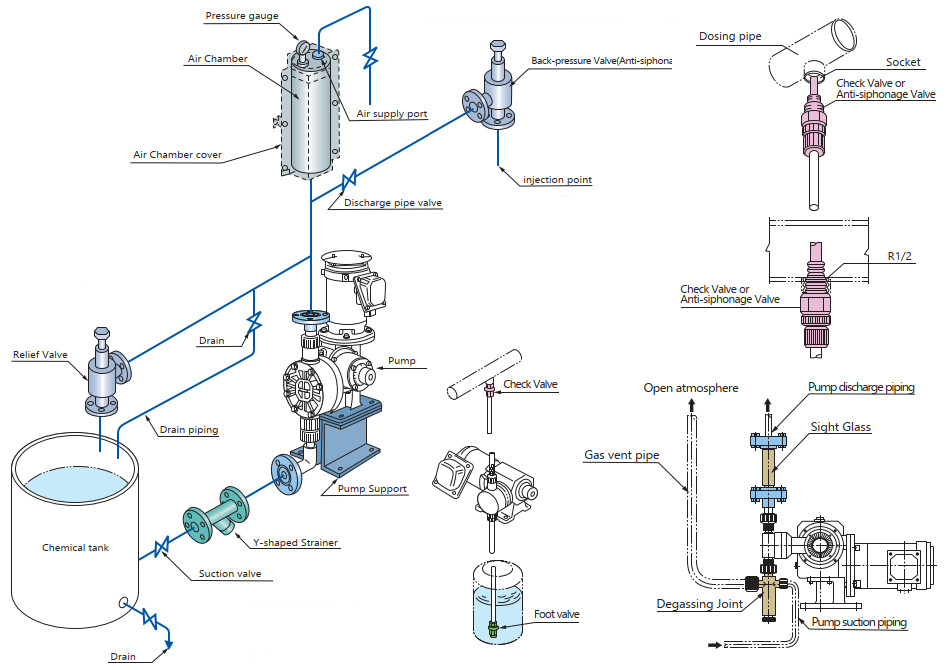Tech & Tools
Technical information
- HOME
- Tech & Tools
- Pump accessories
Pump accessories

| Air chamber | The air chamber uses the compressibility of air to make the pulsating flow from the pump almost continuous, preventing acceleration resistance, overfeeding phenomenon, vibration of piping, etc., _and prolonging the life of the diaphragm pump itself. Useful. Install the air chamber as much as possible. Air replenishment is required. |
|---|---|
| safety valve | If you forget to open the discharge side piping valve of the pump, _or if you start the pump operation with the discharge side piping blocked for some reason, the deadline operation will occur _and the air chamber, pump, piping, etc. will be damaged. The safety valve is a valve that prevents this damage _and opens at the set pressure. Please give due consideration to anti-freezing measures. Note) Mounting position When returning to the suction tank, install it above the liquid level in the suction tank. Also, always open the discharge side of the safety valve to the atmosphere. [Because the set pressure of the safety valve decreases due to the secondary pressure] |
| Y type strainer | It is inevitable that dust, scale _and other foreign matter will be mixed in the pump pump. If these foreign substances flow into the pump _and get caught in the valve seat _or are damaged, the quantitativeness of the pump cannot be maintained. Therefore, install a strainer on the suction side of the pump. The Y-type strainer can easily remove the filter net unit. |
| Foot valve | The foot valve is placed on the suction side of the pump _and is used for suction piping. Even if the pump stops, the priming [liquid] time can be shortened by the valve that retains the liquid in the suction pipe for a certain period of time. There is also a net for removing dust. |
| Back pressure valve | If the differential pressure between the discharge side _and the suction side of the pump is small, an overfeeding phenomenon will occur due to the pulsatile flow in the pipe. The back pressure valve is a valve that prevents this phenomenon. By applying back pressure to the discharge side, the check ball of the pump becomes tighter _and the discharge amount becomes stable. |
| Siphon prevention valve | If the pressure is lower on the discharge side than on the suction side of the pump, the liquid will flow out spontaneously. It is a valve to prevent the natural outflow. |
| Check valve | The check valve is a valve to prevent backflow when the pump is stopped. |
| Defoaming joint | Air that has flowed in from the suction side _or chemicals that easily generate gas, such as sodium hypochlorite _and chlorine, may not be able to be discharged due to gas locks. The defoaming joint is attached to the suction side of the pump to separate the air _and gas that have flowed in from the suction pipe, _and only the chemical solution is sent to the pump. The suction side of the pump should be pushed in so that air _and gas do not collect, _and the gas vent pipe should be above the liquid level of the suction tank _and open to the atmosphere. |
| Flow indicator | Attached to the discharge side of the pump, the discharge operation can be confirmed, which helps prevent problems such as no injection. |
* Periodically disassemble each accessory _and clean the deposits _and dust with fresh water.
* Depending on the actual metering pump installation and piping [hose] construction conditions, check the maximum acceleration resistance, overfeeding, siphon, cavitation phenomenon, etc. in addition to the maximum piping loss to fully demonstrate the metering pump performance. Please give me.
Head Office
1-12-11 Tagawakita, Yodogawa-ku,Osaka
532-0021
Overseas Business Department
TEL +81-6-6301-6460
FAX +81-6-6308-3022




